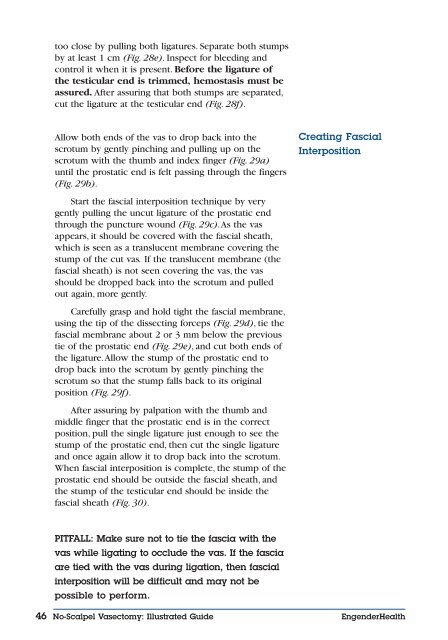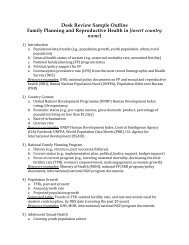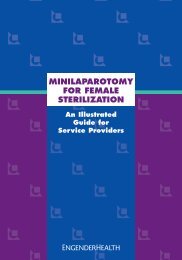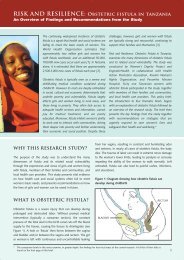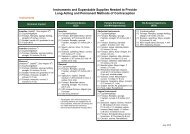No-Scalpel Vasectomy: An Illustrated Guide for ... - EngenderHealth
No-Scalpel Vasectomy: An Illustrated Guide for ... - EngenderHealth
No-Scalpel Vasectomy: An Illustrated Guide for ... - EngenderHealth
Create successful ePaper yourself
Turn your PDF publications into a flip-book with our unique Google optimized e-Paper software.
too close by pulling both ligatures. Separate both stumpsby at least 1 cm (Fig. 28e). Inspect <strong>for</strong> bleeding andcontrol it when it is present. Be<strong>for</strong>e the ligature ofthe testicular end is trimmed, hemostasis must beassured. After assuring that both stumps are separated,cut the ligature at the testicular end (Fig. 28f).Allow both ends of the vas to drop back into thescrotum by gently pinching and pulling up on thescrotum with the thumb and index finger (Fig. 29a)until the prostatic end is felt passing through the fingers(Fig. 29b).Creating FascialInterpositionStart the fascial interposition technique by verygently pulling the uncut ligature of the prostatic endthrough the puncture wound (Fig. 29c).As the vasappears, it should be covered with the fascial sheath,which is seen as a translucent membrane covering thestump of the cut vas. If the translucent membrane (thefascial sheath) is not seen covering the vas, the vasshould be dropped back into the scrotum and pulledout again, more gently.Carefully grasp and hold tight the fascial membrane,using the tip of the dissecting <strong>for</strong>ceps (Fig. 29d), tie thefascial membrane about 2 or 3 mm below the previoustie of the prostatic end (Fig. 29e), and cut both ends ofthe ligature.Allow the stump of the prostatic end todrop back into the scrotum by gently pinching thescrotum so that the stump falls back to its originalposition (Fig. 29f).After assuring by palpation with the thumb andmiddle finger that the prostatic end is in the correctposition, pull the single ligature just enough to see thestump of the prostatic end, then cut the single ligatureand once again allow it to drop back into the scrotum.When fascial interposition is complete, the stump of theprostatic end should be outside the fascial sheath, andthe stump of the testicular end should be inside thefascial sheath (Fig. 30).PITFALL: Make sure not to tie the fascia with thevas while ligating to occlude the vas. If the fasciaare tied with the vas during ligation, then fascialinterposition will be difficult and may not bepossible to per<strong>for</strong>m.46 <strong>No</strong>-<strong>Scalpel</strong> <strong>Vasectomy</strong>: <strong>Illustrated</strong> <strong>Guide</strong> <strong>EngenderHealth</strong>


